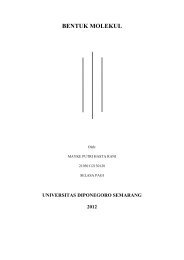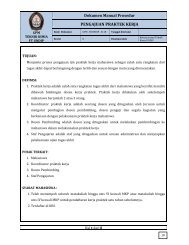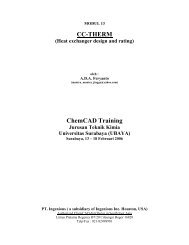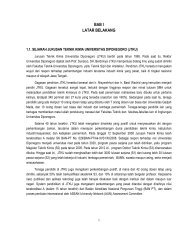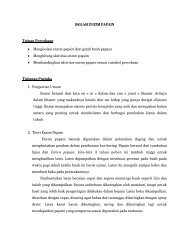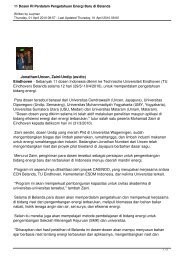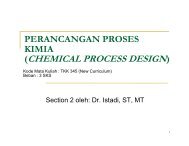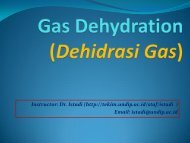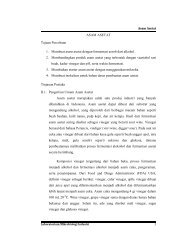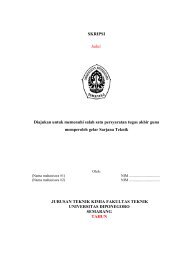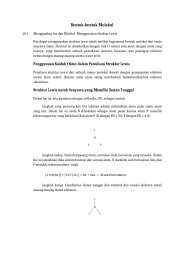Alkylation of Benzene by Propylene to Cumene 6
Alkylation of Benzene by Propylene to Cumene 6
Alkylation of Benzene by Propylene to Cumene 6
- No tags were found...
You also want an ePaper? Increase the reach of your titles
YUMPU automatically turns print PDFs into web optimized ePapers that Google loves.
6.4 Mass Balance and Simulation 185<strong>of</strong> propylene <strong>to</strong> cumene <strong>of</strong> about 88%, in good agreement with the experimentaldata for MCM - 22 and beta - zeolite [7] , as well as a reasonable amount <strong>of</strong> DIPBs.The formation <strong>of</strong> secondary products reaches a plateau <strong>to</strong>ward the exit <strong>of</strong> thereac<strong>to</strong>r. The DIPB ’ s distribution is about 5% ortho, 40% meta and 55% para, withless than 0.3% oligomers. Dividing the <strong>to</strong>tal throughput <strong>by</strong> the amount <strong>of</strong> catalystgives a weight hourly space velocity (WHSV) <strong>of</strong> 11, or a residence time <strong>of</strong> 5 min.These values are in good agreement with the industrial practice.To increase the overall yield, the DIPB is reconverted <strong>to</strong> cumene in a transalkylationreac<strong>to</strong>r in the presence <strong>of</strong> a large excess <strong>of</strong> benzene. The same zeolite catalystmay be used. Practical data for the design are temperatures <strong>of</strong> 140 – 150 ° C, benzene/DIPB ratios between 20 – 30 and a WHSV <strong>of</strong> 2 <strong>to</strong> 3.6.4Mass Balance and SimulationAt the reac<strong>to</strong>r outlet the reaction mixture has a temperature <strong>of</strong> 230 ° C and a pressure<strong>of</strong> 34 bar, the molar composition being 86.6% benzene, 12.6% cumene and0.8% DIPB. Other components are lights , in this case the propane entered withthe feed, and heavies , lumped as tri - propylbenzene.By examining a list <strong>of</strong> physical properties in Table 6.4 , it can be seen that thefreezing point cannot be exploited for separations. The relatively wide boilingpoints show good opportunities for separations <strong>by</strong> distillation. Note that if hexeneforms <strong>by</strong> propane dimerization it will accumulate in the benzene recycle loopbecause its removal is very difficult.Because <strong>of</strong> the quasi - ideal VLE <strong>of</strong> binary mixtures, the boiling points <strong>of</strong> componentssuggests the sequencing <strong>of</strong> separations. Following the heuristics in Chapter3 the removal <strong>of</strong> lights has <strong>to</strong> be done in the first place. The first separation (C - 1)is the depropanizer column. The pressure is selected so as <strong>to</strong> ensure the condensation<strong>of</strong> the <strong>to</strong>p product <strong>by</strong> air cooling. Next, follows the separation <strong>of</strong> the ternarymixture benzene/IPB/DIPB. Because <strong>of</strong> the large benzene amount the “ directsequence ” is the best choice. The recovery <strong>of</strong> benzene takes place in the column(C - 2). If follows the separation cumene/DIPB in the column (C - 3), this time operatedunder vacuum and constrained <strong>by</strong> the reboiler temperature. DIPB recoveredfrom heavies in the vacuum distillation column (C - 4) is sent <strong>to</strong> the transalkylation,<strong>to</strong>gether with an appropriate amount <strong>of</strong> recycled benzene. It may be seen that theabove flowsheet is the same as the technology displayed in Figure 6.1 . The simulationfollows the flowsheet in Figure 6.7 .The design <strong>of</strong> the distillation columns deserves some comment. A pressure <strong>of</strong>12 bar is convenient for (C - 1) because it gives a bot<strong>to</strong>ms temperature below 200 ° Cand a condenser temperature <strong>of</strong> 34 ° C. The design should prevent loss <strong>of</strong> benzenein the <strong>to</strong>p product, which is used as GPL fuel. The feed temperature is kept a<strong>to</strong>ptimum, <strong>by</strong> trading the hot utility consumption against recovery. Note that inthis case the shortcut predesign <strong>by</strong> Underwood – Gilliland is very different fromthe rating design <strong>by</strong> Radfrac. The following configuration ensures a high recovery



